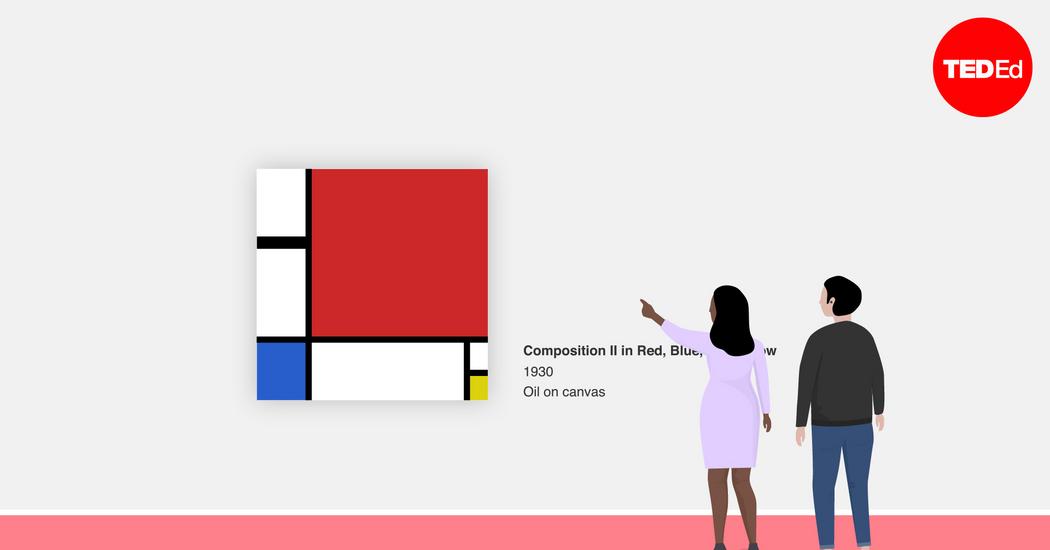(单词翻译:单击)
Dutch artist Piet Mondrian's abstract, rectangular paintings inspired mathematicians to create a two-fold challenge.
荷兰艺术家皮特·蒙德里安的抽象长方形绘画,启发数学家们创造了一个双重挑战。
First, we must completely cover a square canvas with non-overlapping rectangles.
首先,我们必须用互不重叠的长方形完整地覆盖一个正方形画布。
All must be unique, so if we use a 1x4, we can't use a 4x1 in another spot, but a 2x2 rectangle would be fine.
所有的长方形必须是独特的,若我们用了1x4的长方形,就不能在其他地方再用4x1的长方形,但是用2x2的正方形就可以。
Let's try that. Say we have a canvas measuring 4x4.
让我们试一下。假设我们有一个4x4的画布。
We can't chop it directly in half, since that would give us identical rectangles of 2x4.
我们不能直接把它劈成两半,因为这会给我们两个一样的2x4的长方形。
But the next closest option -- 3x4 and 1x4 -- works. That was easy, but we're not done yet.
但是下一种可行的方式就是一个3x4和一个1x4。这很简单,但是我们还有没结束。
Now take the area of the largest rectangle, and subtract the area of the smallest.
现在我们看看其中最大的长方形面积,然后与最小的长方形面积相减。
The result is our score, and the goal is to get as low a score as possible.
结果就是我们的分数,目标是得分越低越好。
Here, the largest area is 12 and the smallest is 4, giving us a score of 8.
对这个来说,最大的面积是12,最小的面积是4,我们的分数就是8。
Since we didn't try to go for a low score that time, we can probably do better.
因为我们没有尝试去找到最低的分数,我们可能可以做得更好。
Let's keep our 1x4 while breaking the 3x4 into a 3x3 and a 3x1.
让我们留下1x4的长方形,并且把3x4的分成3x3的和3x1。
Now our score is 9 minus 3, or 6. Still not optimal, but better.
现在我们的分数是9减3,6分。还不是最小值,但是比之前好了。
With such a small canvas, there are only a few options.
对于这么小的画布,我们的选择不是很多。
But let's see what happens when the canvas gets bigger.
但是让我们来看看当画布变大时会发生什么。
Try out an 8x8; what's the lowest score you can get?
试一试8x8的,你能得到最低的分数是多少呢?
To get our bearings, we can start as before: dividing the canvas roughly in two.
为了理解我们的想法,我们可以从之前开始:把画布先粗略的分成两半。
That gives us a 5x8 rectangle with area 40 and a 3x8 with area 24, for a score of 16. That's pretty bad.
这给我们一个5x8的长方形,有着40的面积,和一个3x8的长方形,有着24的面积,这样我们就有16分。这是个糟糕的分数。
Dividing that 5x8 into a 5x5 and a 5x3 leaves us with a score of 10. Better, but still not great.
把5x8的再分成5x5和5x3,我们就能得到10分。好一点了,但是还不是最好的。
We could just keep dividing the biggest rectangle.
我们可以继续分割最大的长方形。
But that would leave us with increasingly tiny rectangles, which would increase the range between the largest and smallest.
但是这样就给我们留下越来越小的长方形,这会增加最大的和最小的长方形的面积差。

What we really want is for all our rectangles to fall within a small range of area values.
我们真正想要的是让我们所有的长方形都处于一个很接近的范围。
And since the total area of the canvas is 64, the areas need to add up to that.
因为画布的总面积是64,所以所有长方形的面积需要加起来是64。
Let's make a list of possible rectangles and areas.
让我们把可能的长方形和面积列出来。
To improve on our previous score, we can try to pick a range of values spanning 9 or less and adding up to 64.
为了提高之前的分数,让我们尝试去挑选一个在9或以下的值,然后加在一起等于64。
You'll notice that some values are left out because rectangles like 1x13 or 2x9 won't fit on the canvas.
你会发现有些数字是要被舍弃的,因为像1x13和2x9的长方形并不能嵌入画布。
You might also realize that if you use one of the rectangles with an odd area like 5, 9, or 15,
你也有可能注意到如果你用了像是5,9或15这样奇数面积的长方形,
you need to use another odd-value rectangle to get an even sum.
你需要用另外一个奇数面积的长方形让它们的和为偶数。
With all that in mind, let's see what works. Starting with area 20 or more puts us over the limit too quickly.
知道了这些,让我们来看看怎样能成功。从大于20的面积开始一下子就把我们限制住了。
But we can get to 64 using rectangles in the 14-18 range, leaving out 15.
但我们可以用14-18范围内的长方形去得到64,除去15。
Unfortunately, there's no way to make them fit.
但是不幸的是,实际上没有方法能把这些长方形放进画布。
Using the 2x7 leaves a gap that can only be filled by a rectangle with a width of 1.
使用2x7的长方形会留下一个缺口,只能被宽度为1的长方形填补。
Going lower, the next range that works is 8 to 14, leaving out the 3x3 square.
如果尝试更低的范围,下一个区间就是8-14,除去3x3的正方形。
This time, the pieces fit. That's a score of 6. Can we do even better? No.
这次,这些长方形能放到画布中去,这个得分是6,我们能做的更好吗?不能。
We can get the same score by throwing out the 2x7 and 1x8 and replacing them with a 3x3, 1x7, and 1x6.
通过移除2x7和1x8的长方形,我们能得到同样的分数,用3x3,1x7和1x6的长方形替代。
But if we go any lower down the list, the numbers become so small
但是如果我们把范围继续下移,那些数字就太小了,
that we'd need a wider range of sizes to cover the canvas, which would increase the score.
所以我们就需要一个更大的范围来填满画布,这样就会提高分数。
There's no trick or formula here -- just a bit of intuition. It's more art than science.
这个问题没有什么巧妙地公式,全凭一点直觉。这不只是科学,更像艺术。
And for larger grids, expert mathematicians aren't sure whether they've found the lowest possible scores.
并且对于更大的方块,数学家们不能确定他们是否发现了可能的最低分。
So how would you divide a 4x4, 10x10, or 32x32 canvas?
你会怎么分割4x4,10x10,或是32x32的画布呢?
Give it a try and post your results in the comments.
试一下,并在评论里发表你的结果吧。


